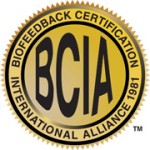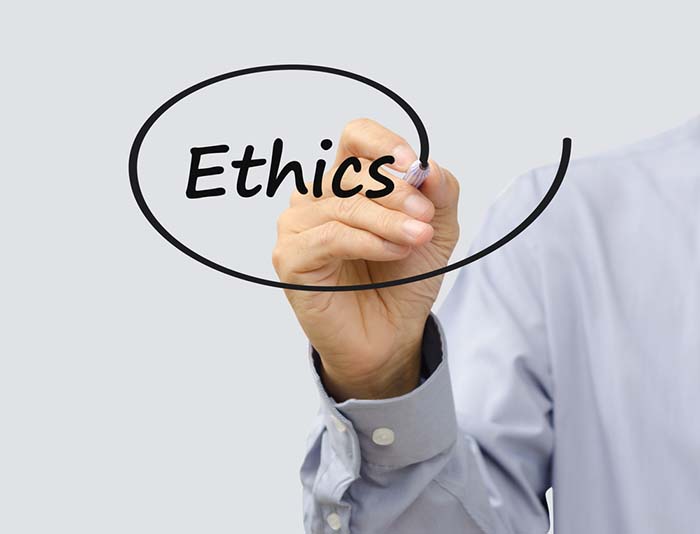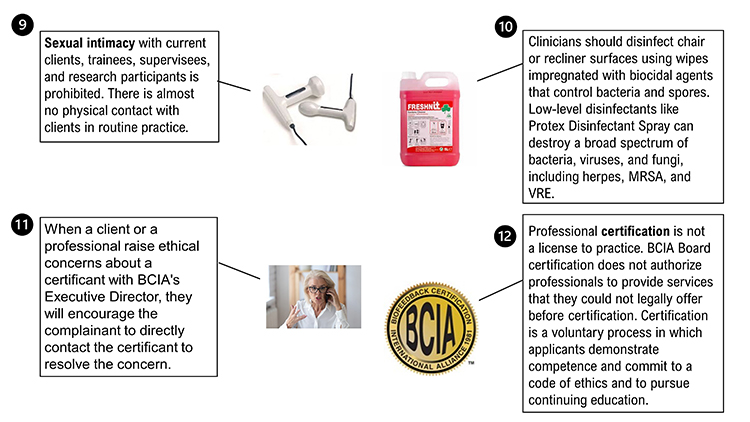The ethical responsibilities of biofeedback providers and their staff are
collectively defined by the licensing act under which they (or their supervisors) operate, their profession, and the
BCIA’s Professional
Standards and Ethical Principles of Biofeedback (9th rev.). The BCIA's PSEP represents the minimum ethical
standards expected of its applicants and certificants. Physicians who provide biofeedback must also follow medical
ethical guidelines. Psychologists must adhere to the Ethical Standards of the APA (Moss, 2013).
Providers deliver biofeedback services within a context of legal statutes, cultural norms, professional standards, and ethical codes that may vary across nations, cultures, and communities. These expectancies may conflict with each other. For example, the American Psychological Association (APA) proscription against dual relationships with clients would prevent a Psychologist from following a community expectation that "healers" visit the client's family and share their religious rituals (Moss & Shaffer, 2016).
Since ethical guidelines can never anticipate all of the contingencies that providers may encounter, they should
always consult with their licensing body, professional association, and colleagues as they reach a choice point and
are uncertain about future conduct. Unfortunately, the most severe ethical infractions, like sexual relationships
with clients, often involve intentional violations of black-and-white rules.
When a licensing body or a court substantiates a charge of ethical misconduct, BCIA may take disciplinary action against a certificant. BCIA does not have the legal authority to compel testimony or the submission of documents. For this reason, it must often wait for a licensing body or court to investigate and reach a decision. When a licensing body or a court substantiates a charge of ethical misconduct, BCIA may take disciplinary action against a certificant. Applicants
who have lost or surrendered their license may not be certified until their license is restored. BCIA has no
enforcement role when an individual charged with an ethical violation is neither a certificant nor an
applicant.
Professional Standards
Professional ethical standards help educators, researchers, and practitioners anticipate and identify ethical dilemmas and make choices that maintain one's professional integrity and protect our clients and profession (Striefel, 2003). Graphic © Andrzej Rostek/iStockphoto.com.

BCIA Blueprint Coverage
This unit supports BCIA's requirement that applicants complete 3 hours of ethics education.

This unit covers The Purpose of Ethics, Diversity and Cultural Awareness, Responsibility, Competence, Scope of Practice, Mentoring vs. Supervision, Ethical Standards, Public Statements, Confidentiality, Protection of Client Rights and Welfare, Biofeedback Equipment Selection, Infection Risk Mitigation, Professional Relationships, Research with Humans and Animals, Adherence to Professional Standards, Ethics Complaint Procedures, and Biofeedback Certification International Alliance (BCIA).
Please click on the podcast icon below to hear a full-length lecture.

Donald Moss, PhD, contributed extensively to chapter content from his AAPB webinar, Professional Ethics and Practice Standards in Biofeedback and Neurofeedback. This video recording is free to AAPB members with a discount code and costs $65 for nonmembers.

Read Shaffer and Schwartz's "Entering the Field and Assuring Competence" in Biofeedback: A Practitioner's Guide (4th ed.) for an in-depth discussion of the challenges of entering the field and maintaining competence.
The Purpose of Ethics
Ethical standards are intended to protect the public, biofeedback, the professions that deliver biofeedback services, and the providers themselves.
Ethical Standards and the Reputation of the Profession of Biofeedback
Biofeedback providers recognize that their effectiveness and success as professionals, and the credibility of the biofeedback field, depend on their professional conduct.Ethical codes express our stakeholders' core values.
Each time a biofeedback or behavioral health professional is charged with serious violations of ethical behavior, the field is also tarnished, and potential patients and their family members lose their readiness to trust in professional care (Moss, 2020).
Listen to a mini-lecture on Core Values © BioSource Software LLC. Graphic © New Africa/Shutterstock.com.

Professional Ethics Reflect Personal Integrity
Ethical practices are in the first place aspirational; they reflect the kind of professional one aspires to become. Responsible behavior in professional life should express personal, social, and religious values. Compassion and empathy for one’s fellow humans, who come for help with suffering, draws individuals to professional practice. Professionals with diminished empathy due to "burnout" and "compassion fatigue" are at greater risk for ethical transgressions.
Burnout is a widespread problem in the helping professions. Compassion fatigue is one product of using up or depleting our capacities for caring. Maintaining healthy self-care practices is critical in avoiding compassion fatigue. Difficulties in establishing rapport and mutual empathy in treatment relationships are also a challenge for professionals. When patients do not feel strong rapport and trust in their provider, they are more likely to file complaints (Moss, 2020).
Beneficence in Biofeedback Practice
"Providers strive to protect their clients’ welfare by appreciating their impact on the clients’ lives, and by recognizing and avoiding the potential for conflicts of interest" (Moss, 2020).
The Investigative Clinician: Beyond Initial Presentations
This section was inspired by Dr. Ron Swatzyna, Director and Chief Scientist of the Houston Neuroscience Brain Center.
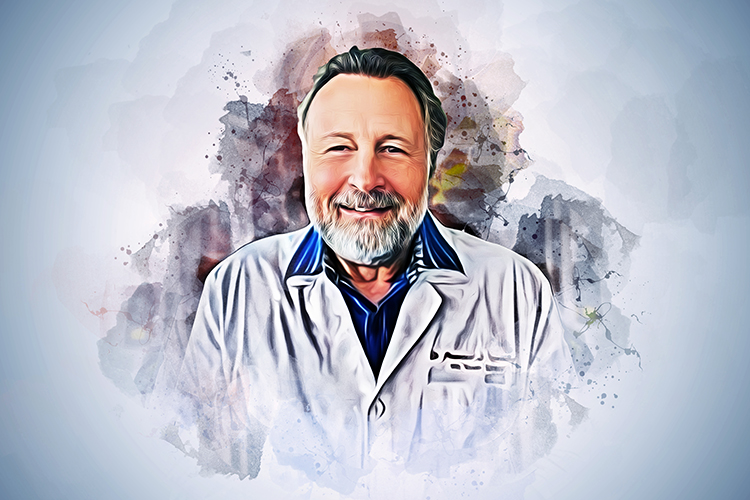
When patients present with significant sudden-onset symptoms or prove resistant to conventional treatments, clinicians must transition from diagnostician to detective. Such symptoms may be behavioral, emotional, cognitive, or somatic, with their significance judged within the context of each particular case. The emergence of abrupt changes, particularly in children and adolescents, should trigger immediate consideration of underlying medical, environmental, or infectious causes rather than immediate psychiatric diagnosis and medication trials.
Several clinical scenarios warrant a deeper investigation: the sudden appearance of new symptoms, particularly in previously stable or healthy individuals; failure to respond to two adequate medication trials; or unexpected resistance to properly administered biofeedback or neurofeedback interventions. In these cases, the standard approach of treating based on DSM-5 diagnostic criteria may obscure crucial underlying pathology and its etiology.
The EEG serves as a particularly valuable tool in this investigative process. Findings of diffuse slowing, intermittent epileptiform discharges, or spindling excessive beta, can provide objective evidence of neuroinflammation or toxic exposure. These EEG patterns often indicate the presence of triggers such as mold exposure, chemical toxicity, or infectious processes that may be driving the presenting symptoms. EEG patterns may also index changes in sleep quality, medication, or drug use. Changes in socially-mediated supports or stressors are sometimes associated with EEG variations.
Case evidence supports this investigative approach. For instance, apparent treatment-resistant depression may actually stem from chronic inflammatory response syndrome (CIRS) due to mold exposure, while sudden-onset obsessive-compulsive symptoms might indicate PANDAS (Pediatric Autoimmune Neuropsychiatric Disorders Associated with Streptococcal Infections) or autoimmune encephalitis. Similarly, new-onset attention deficits resistant to standard treatments might result from environmental toxin exposure or nutrient deficiencies rather than primary ADHD.
The clinical implications are clear: when standard treatments fail or symptoms appear abruptly, clinicians should look beyond the presenting symptoms to investigate potential environmental, infectious, or systemic causes. This may involve evaluation for mold exposure, testing for inflammatory markers, assessment of nutrient status, or screening for environmental toxins. The goal is to identify and address the underlying cause rather than simply managing symptoms through psychiatric medication.
This approach requires a paradigm shift from treating DSM-5 diagnoses to treating underlying pathophysiology. While DSM-5 criteria remain valuable for classification and communication, they should not constrain the search for root causes when clinical presentation or treatment response suggests deeper issues.
The presence of objective findings such as EEG abnormalities should particularly prompt investigation of environmental or systemic causes, even when presenting symptoms appear purely psychiatric. By adopting this investigative mindset, clinicians can identify and address root causes that might otherwise go undetected, potentially leading to more effective and lasting therapeutic outcomes. This approach may require additional time and resources initially, but it can prevent years of ineffective symptom management and improve long-term patient outcomes.
Diversity and Cultural Awareness
Since professionals provide biofeedback services across diverse communities, cultures, nations, and geographic regions, they must respect the norms of the cultures they serve and recognize the diversity in legal codes, professional standards, and ethical principles.

Listen to Dr. Moss discuss Diversity and Cultural Awareness © Association for Applied Psychophysiology and Biofeedback. You can enlarge the video by clicking on the bracket icon at the bottom right of the screen. When finished, click on the ESC key.
They may have to resolve conflicts between the ethical standards of their professional society and community norms. For example, while the American Psychological Association proscribes "dual relationships," like friendship with a client, community norms may require family visits and participation in religious rituals intended to heal the client (Moss, 2013). Graphic © Rawpixel.com/Shutterstock.com.

Responsibility
One of the most severe challenges to biofeedback is its credibility. A field is judged by the competence and actions of each provider. They should acquire entry-level competence in biofeedback and then progressively expand their expertise through activities like continuing education. They must adhere to the ethical principles that govern their professional practice and accept personal responsibility for the consequences of their actions. Graphic © Boris15a/Shutterstock.com.
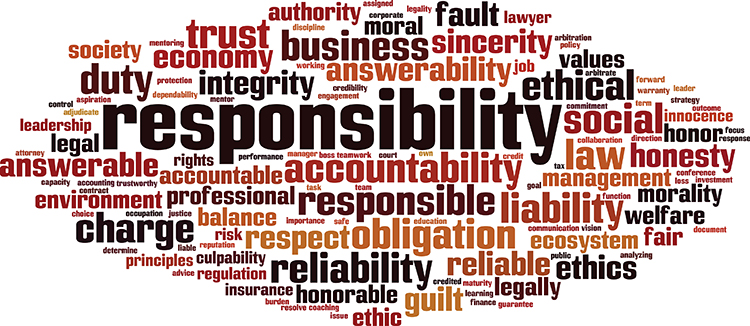

Listen to Dr. Moss discuss responsibility © Association for Applied Psychophysiology and Biofeedback.
As practitioners, they should provide cost-effective services consistent with the highest professional standards. They should educate their clients, referring health professionals, and third-party payers about the rationale for assessment and training procedures, the strength of empirical support for a treatment, and its risks, costs, and benefits. They should always explain when a treatment is experimental since this is crucial to informed consent and is a frequent source of ethical complaints in biofeedback. Ideally, they should obtain written informed consent for their proposed treatment. They never recommend experimental treatments when an untried well-supported treatment is already available. Providers should only suggest less-documented interventions after informing clients of the available treatment options and the empirical support for each. Then, they should obtain written informed consent for the experimental procedure (Moss, 2013).
They strive to protect their clients’ welfare by appreciating their impact on their clients’ lives and recognizing and avoiding potential conflicts of interest. They candidly communicate with their clients about their progress and modify or discontinue training if clients fail to make progress. When their clients require services outside their expertise, they refer them to qualified professionals and never abandon them. Graphic © Rido/Shutterstock.com.

When clients do not improve and require an intervention that a clinician is not qualified to provide, options include referral to a qualified provider or consultation with or supervision by a qualified professional.
As educators, they help advance knowledge through research and encourage students to value knowledge, think critically and from an interdisciplinary perspective, be reflective thinkers, appreciate the strengths and limitations of competing perspectives, and objectively investigate the questions that concern them. Educators recognize their potential impact on their students, strive to provide accurate, complete, and objective information, and encourage free inquiry. Where there are scientific controversies, educators help students understand opposing positions and encourage them to evaluate each side’s scientific support.Competence
Applicants first gain entry-level competence in biofeedback through didactic education, mentoring, and practice. Listen to Dr. Moss explain competence © Association for Applied Psychophysiology and Biofeedback.
Entry-Level Competence
New biofeedback practitioners should acquire entry-level competence in biofeedback and expand their expertise through activities like continuing education. BCIA certification ensures that the provider has completed training and mastered the skills and knowledge for entry-level competence and that the certificant also receives continuing education for Recertification (Moss, 2020)
Competence
Knowing a biofeedback technique is not sufficient when beginning to treat a new patient group. A professional who wishes to treat dissociative disorders, seizure disorders, or major mood disorders must also gain knowledge and experience, through appropriate education and supervision, of the condition and its management. Even expert application of biofeedback therapies for delicate conditions may trigger an emotional or medical crisis, and the therapist must know how to manage such events (Moss, 2020).

Maintaining Competence
Certificants progressively expand their expertise through continuing education, including teleseminars, massive open online courses (MOOCs), workshops, conference presentations, classes, reading journal articles and texts, mentoring, and their scholarship (Striefel, 2004). Providers consult experienced practitioners and obtain clinical supervision when expanding their clinical practice into new applications, equipment and software, and protocols (Moss, 2013). This ensures they practice within the scope of their expertise (Moss & Shaffer, 2016). Graphic © Eti Ammos/Shutterstock.com.
Competent providers critically evaluate biofeedback outcome studies, guide their practice using peer-reviewed findings, and strive to use the best practices in the field. They maintain a current understanding of the efficacy of biofeedback interventions and recognize where it is indicated and contraindicated (Moss, 2013).
AAPB's Evidence-Based Practice in Biofeedback and Neurofeedback (3rd ed.) provides an authoritative evaluation of the efficacy of biofeedback applications.
Listen to a mini-lecture on Evidence-Based Practice © BioSource Software LLC.
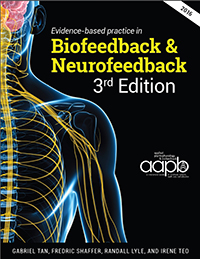
They comply with applicable laws and the ethical standards of their profession and certifying organization. Providers require a government license or credential to treat a medical or psychological disorder independently. Those without a license or credential must obtain appropriate supervision to treat these disorders. "Supervision" is legally defined by states within their practice acts. A supervisor oversees the unlicensed individual's delivery of services and assumes legal responsibility for provided care. Supervision should not be confused with consultation, where the licensed individual has no legal responsibility for the unlicensed provider's actions.
They accurately disclose their regionally-accredited degrees, training, specialty areas, experience, and their license or credential and certification status. Ethical providers recognize that participation in a membership organization does not imply competence and that certification is not a license for independent practice.
BCIA professionals who treat medical or psychological conditions must demonstrate professional competence as defined by applicable local, state, and national licensing/credentialing laws. BCIA certification becomes invalid when a license is suspended, revoked, or not renewed due to an investigation of a complaint, and the individual is not allowed to provide services under supervision. A professional may only apply for recertification after the license has been reinstated.
It is illegal to treat medical or psychological conditions without appropriate supervision if you are not licensed or credentialed to do so. BCIA certification becomes invalid when a certificant loses and cannot replace appropriate supervision. An individual may only apply for recertification after documenting that appropriate supervision has been reestablished. (BCIA, 2016).
Scope of Practice
Practitioners' scope of practice defines the services they may legally provide under their license or supervisor's license under state law. Graphic retrieved from the AOA State Government Relations Center.
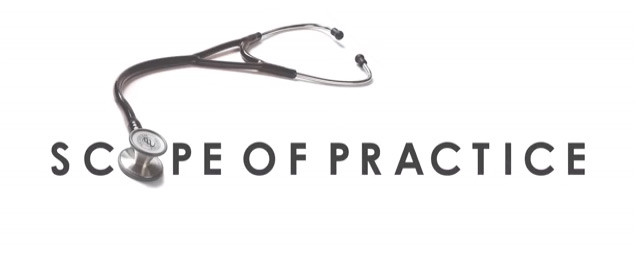
Listen to Dr. Moss explain scope of practice © Association for Applied Psychophysiology and Biofeedback.
Compliance with Relevant Laws
Providers comply with applicable laws and the ethical standards of their profession and certifying organization. They require a government license or credential to treat a medical or psychological disorder independently. Those without a license or credential must obtain appropriate supervision to treat these disorders. BCIA certifies licensed practitioners to treat diagnosed disorders, technicians to treat diagnosed disorders under supervision, and non-licensed practitioners to apply biofeedback for relaxation, stress management, or optimal performance (Moss, 2020).
Listen to Dr. Moss explain compliance © Association for Applied Psychophysiology and Biofeedback.
For example, psychologists may not make nutritional recommendations in most states, and health coaches may not diagnose or treat medical or psychological disorders (Moss, 2013). Although BCIA certifies technicians to practice under supervision, their scope of practice is defined by their supervisor's scope of practice (Moss, 2020). Artist: Dani S@unclebelang on Fiverr.
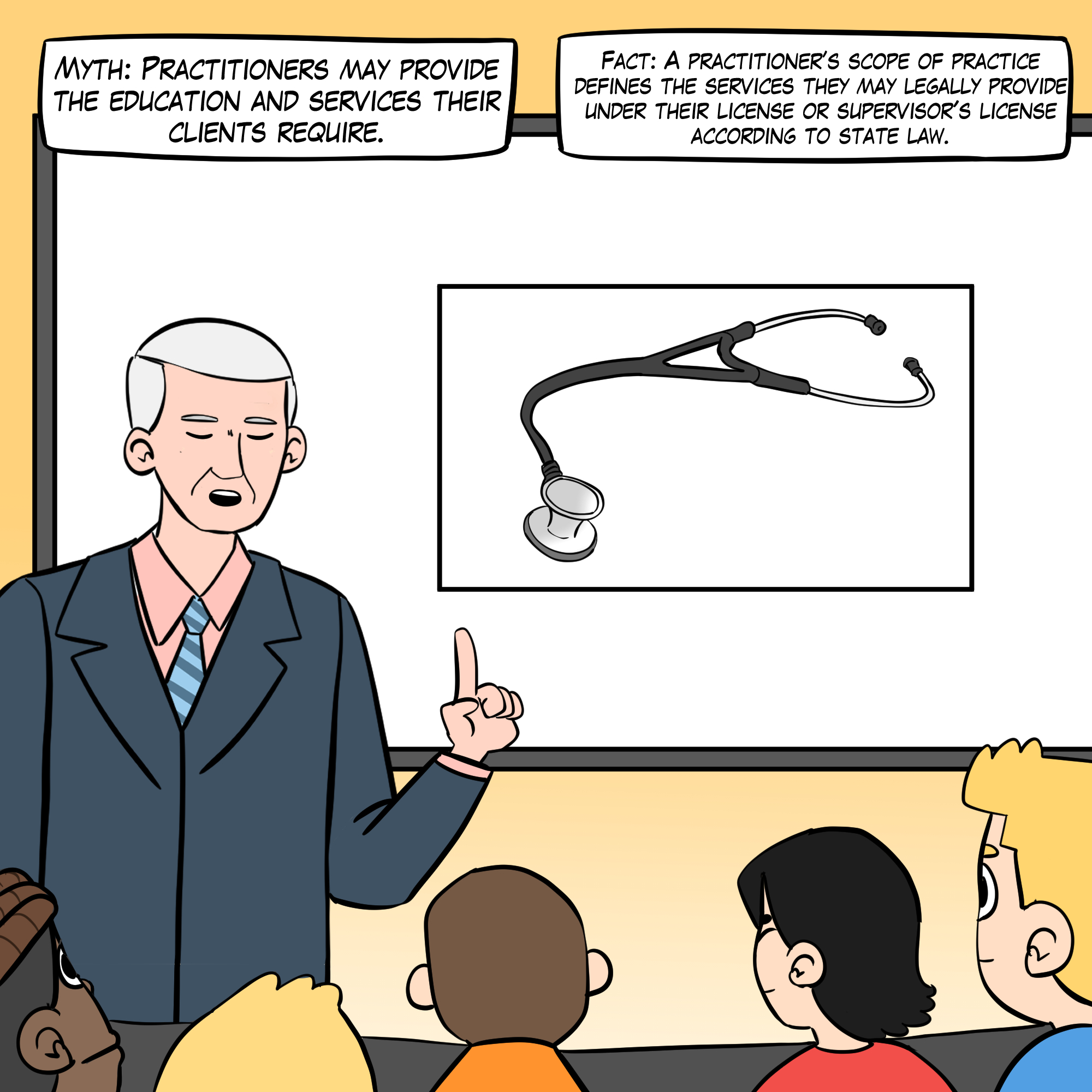

For example, psychologists may not make nutritional recommendations in most states, and health coaches may not diagnose or treat medical or psychological disorders (Moss, 2013). Although BCIA certifies technicians to practice under supervision, their scope of practice is defined by their supervisor's scope of practice (Moss, 2020).
Scope of practice is the largest elephant in the room. Until they face complaints, licensed practitioners rarely read the statutes that regulate their scope of practice and professional responsibilities (Hopkins, 2013). Unlicensed certificants may not understand how the scope of practice applies to their activities or their supervisor's license limitations. Without an appropriate license, they may not even legally purchase FDA-regulated devices like electrocephalographs. Graphic © Aleksandr_Kuzmin/Shutterstock.com.

Scope vs. Competence
Licensure defines whether a procedure is allowed for a professional with a given license – the professional’s scope of practice. The principle of competence requires that a practitioner also know and train to use a procedure and deal with a specific patient population. Responsible practitioners will practice within the limits of their competence/expertise. When undertaking new applications of biofeedback, it is essential to obtain training on the application and relevant techniques and seek supervision by a professional with experience in biofeedback treatment of this disorder or the use of this technique (Moss, 2020).
MENTORING VS. SUPERVISION
BCIA requires mentoring as an educational process for individuals seeking BCIA certification. Graphic © fizkes/Shutterstock.com.

BCIA requires legal clinical supervision for individuals certified as technicians. Peer consultation with colleagues and consultation with area experts are recommended as lifelong strategies to assure the quality of care and to protect against potential patient complaints (Moss, 2020).
Listen to Dr. Moss explain the difference between mentoring and supervision © Association for Applied Psychophysiology and Biofeedback.
Mentoring Defined
Mentoring is the "process of transmitting knowledge and skills from the trained to the untrained or the experienced to the inexperienced practitioner. Mentoring involves a relationship between a mentor and candidate that promotes the development of skill, knowledge, responsibility, and ethical standards in the practice of biofeedback"' (bcia.org).
Typically, the mentor does not assume legal responsibility for the mentee's patients receiving treatment or training. The mentor’s focus is on the planning and delivery of biofeedback services, not on the entirety of the client’s care (Moss, 2020).
Real Genius WEBTOONs by Dani S@unclebelang developed in collaboration with Dr. Don Moss.
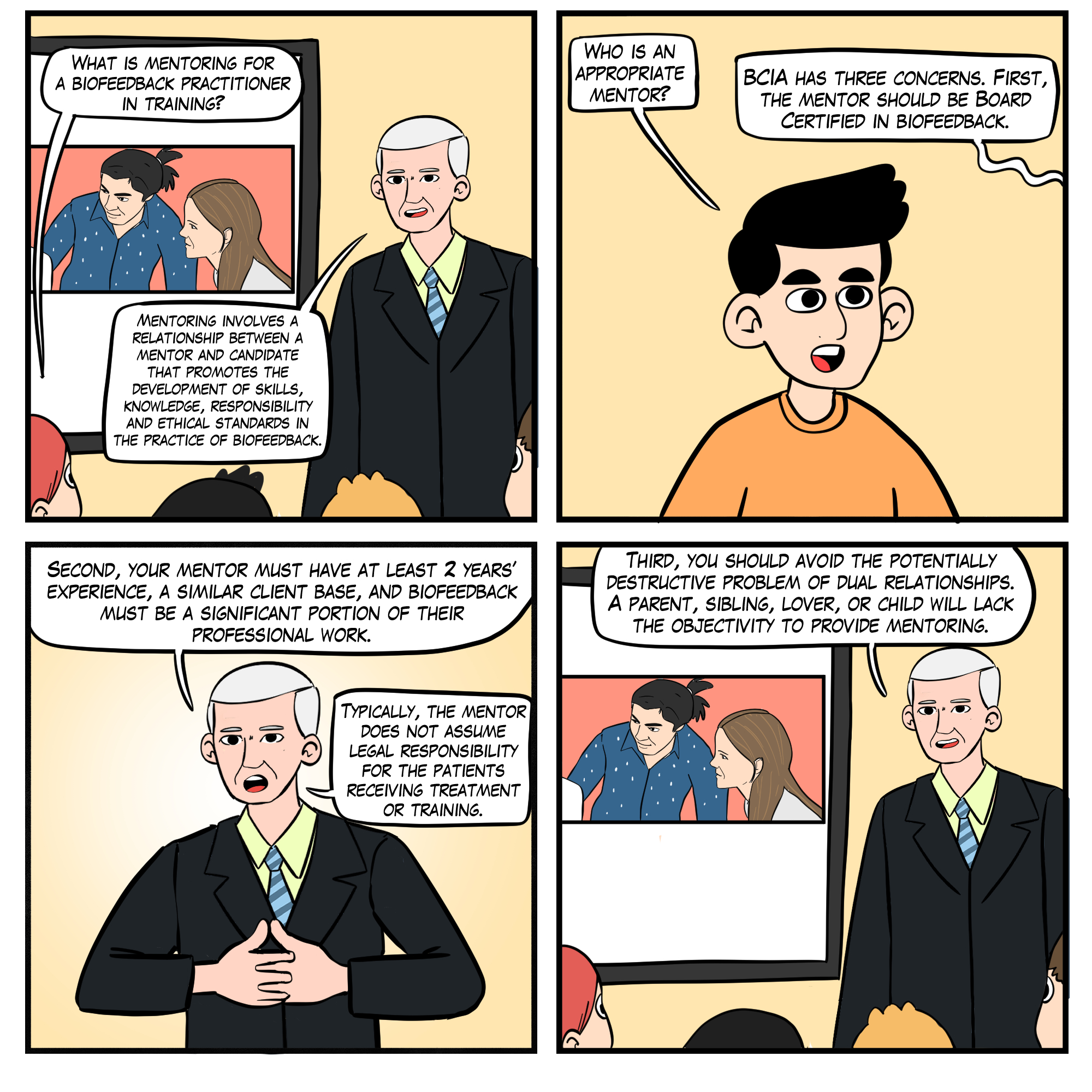
Supervision Defined
Supervision is providing guidance for clinical practice for qualified health professionals by a more experienced health professional. In supervision, the supervisor assumes some legal responsibility (and liability) for the quality of care and the patient’s wellbeing in the treatment process. A supervisor is responsible to remain cognizant of the entirety of the technician’s caseload, client assessment, treatment planning, and treatment delivery (Moss, 2020).
Graphic © goodluz/Shutterstock.com.

Unacceptable Supervision
Since supervisors assume legal responsibility for client care, they must be physically present at the site where an applicant or unlicensed certificant works. BCIA rejects applications from technicians whose supervisors are not licensed and not legally allowed to supervise biofeedback services.Real Genius WEBTOONs by Dani S@unclebelang developed in collaboration with Dr. Don Moss.
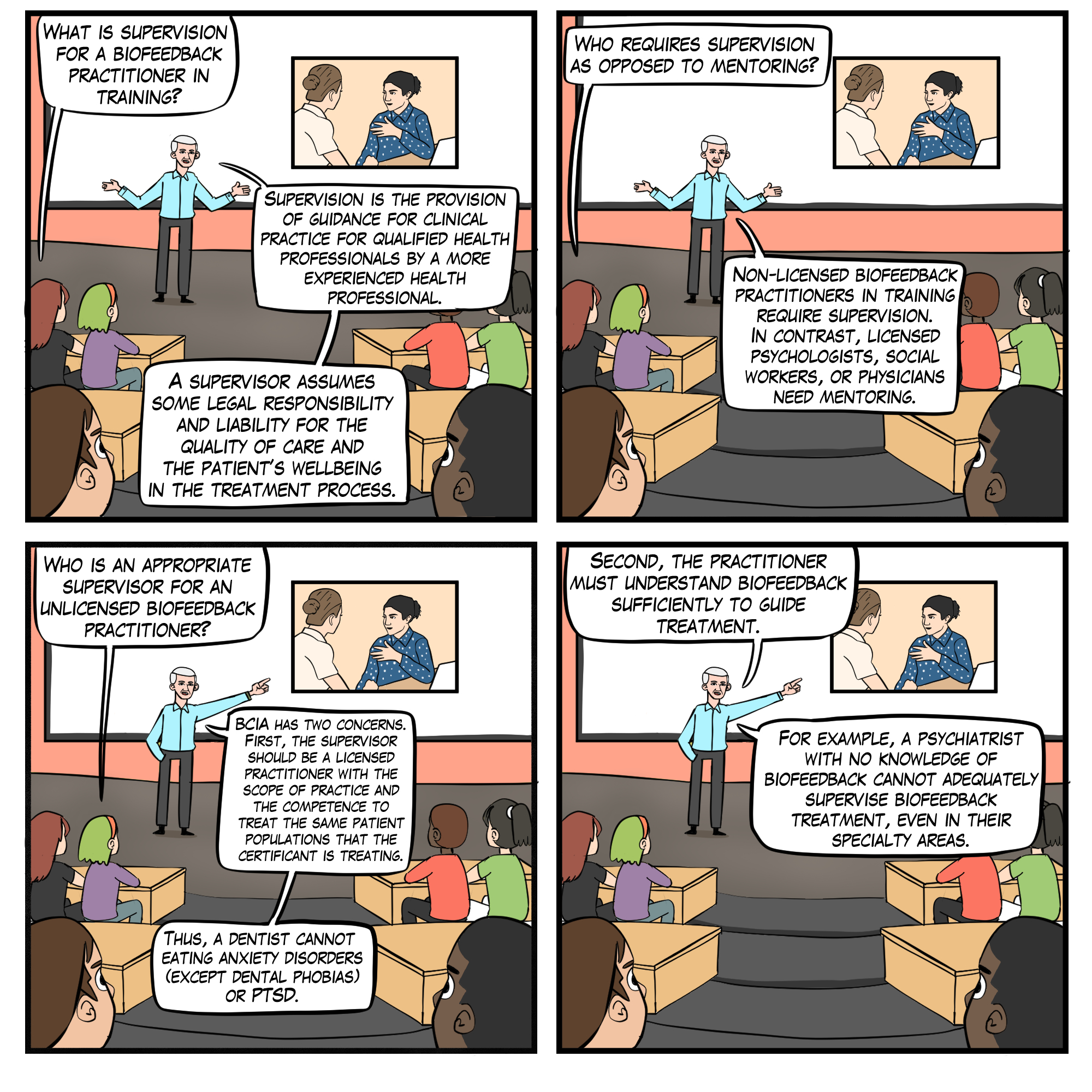
Ethical Standards
Biofeedback providers recognize their effectiveness and the field's credibility depends on their professional conduct. They only bill for the services they or supervised staff provide. When billing third-party payers, they conscientiously follow the payers’ rules and regulations. This includes conservatively using billing codes, obtaining written agreement in advance to use specific codes, differentiating the services they provide from those provided by their supervisees, and accurately describing staff credentials.

Providers have fiduciary responsibility.
Listen to a mini-lecture on Fiduciary Responsibility © BioSource Software LLC. Graphic © WIN12_ET/Shutterstock.com.

They understand that the appearance of a conflict of interest can be as damaging to their reputation as an actual conflict. Whenever possible, they proactively identify potential conflicts and avoid them. For example, workshop presenters should refrain from promoting their products. When a conflict of interest cannot be avoided, they quickly resolve it. For example, providers who serve on boards often recuse themselves from decisions that involve their financial interests.
Client education should include detailed information about assessment and treatment procedures, billing and fee collection, protection of confidentiality, and the limits of confidentiality. Providers should provide clients with a copy of these policies to read as they are carefully explained and only accept written consent when clients indicate they understand them. Informed consent is essential for experimental treatment procedures, which may have a higher risk of failure and client dissatisfaction.
Public Statements
Providers understand that all public statements, ranging from educational talks to the description of services on their website, should be accurate, comprehensive, and conservative to facilitate informed consumer choices. They confine statements about biofeedback to scientifically supported information and communicate the limitations, uncertainties, and strength of these findings. "Discussion of treatment options in marketing materials and professional publications should be evidence-based and current" (Moss, 2020). Graphic © Redaktion93/Shutterstock.com.

Listen to Dr. Moss discuss public statements © Association for Applied Psychophysiology and Biofeedback.

Professional Credentials and Transparency in Marketing and Promotion
Biofeedback providers must accurately disclose their degrees, training, specialty areas, experience, and the status of license or credential and certification. Advertisements for clinical practice should include only treatment or practice-relevant and regionally accredited academic degrees. Example: A PhD in French literature or mathematics should not be included on a business card or in an advertisement. It would mislead the potential client to assume the provider has doctoral-level clinical education.Listen to Dr. Moss discuss marketing © Association for Applied Psychophysiology and Biofeedback.
Example: Current controversy over nurses with PhD or DPN advertising their practices under the title, “Dr. Frances Schmidt.” Unless the practitioner uses a further heading to clarify, this seems to mislead the patient to believe Dr. Schmidt is an MD. The appropriate title would be Dr. Frances Schmidt, Clinical Nurse Specialist.
Participation in a membership organization such as AAPB or ISNR does not imply competence. Advertisement of one’s professional association membership misleads the health consumer to assume that membership assures training and competence. Advertising BCIA and other forms of certification are legitimate ways to show competence (Moss, 2020).
Since professional standards are the foundation of clinical practice, BCIA Board voted to apply the American Psychological Association’s standard on listing professional credentials to its Board Certified Practitioner and Mentor Directory. Certificants may only list the degrees earned in a BCIA-approved healthcare field from regionally-accredited academic institutions (Crawford & Shaffer, 2014).
They carefully explain the efficacy of biofeedback procedures and the costs, benefits, and limitations of commercial services and products. They cautiously endorse the services and products of others, disclose potential conflicts of interest, and ensure that their statements are not misused.
Their professional communications, including business cards, directory listings, letterheads, marketing brochures, and websites, are accurate and consistent with the standards of their professional associations. They seek guidance from colleagues, BCIA, and their professional associations whenever they are uncertain about ethical issues or their objectivity.
Copyright
BCIA professionals uphold the highest standards of ethical conduct in all facets of their practice, including the respectful use and dissemination of copyrighted materials. This commitment is rooted in the recognition that copyright laws are designed to protect the intellectual property rights of creators, thereby encouraging the continued creation and distribution of valuable resources. Graphic © lurii Motov/Shutterstock.com.

The following guidelines aim to clarify the principles of fair use and delineate the boundaries of copyright infringement, especially when presenting public talks, webinars, and distributing handouts.
- Understanding Copyright and Fair Use: BCIA professionals acknowledge that copyrighted materials, such as graphics, videos, and texts, are the legal property of their creators. Using such materials in presentations, webinars, or handouts without proper authorization or acknowledgment can infringe on copyright holders' rights. Fair use is a legal doctrine that permits limited use of copyrighted material without requiring permission from the copyright holders, primarily for purposes such as criticism, comment, news reporting, teaching, scholarship, or research. BCIA professionals must educate themselves on the nuances of fair use to navigate the complexities of copyright law effectively.
- Allowed Uses in Public Talks and Webinars: When presenting public talks or conducting webinars, BCIA professionals may incorporate copyrighted materials under the principles of fair use, provided that the use is for educational, non-commercial purposes, contributes to the creation of new knowledge or insight, and does not substitute for the original work. Short excerpts of text, small, low-resolution images, or brief video clips are more likely to be considered fair use. However, professionals should always provide proper attribution to the original source.
- Proscribed Uses and Avoiding Infringement: BCIA professionals must avoid using copyrighted materials in a manner that could be construed as an infringement. This includes the use of copyrighted materials in their entirety, such as full-length videos, unaltered graphics, or entire book chapters, especially when such use could compete with the market for original works. When planning to use copyrighted materials extensively, BCIA professionals should seek permission from the copyright holder.
- Use in Webinars with and without Handouts: The same principles of fair use apply to webinars, whether handouts are provided or not. When distributing handouts, either electronically or in print, that include copyrighted materials, BCIA professionals must ensure that the inclusion of such materials falls within the guidelines of fair use and that the materials are essential for educational purposes. If distributing copyrighted material is necessary, obtaining permission from the copyright holder is advised to avoid infringement.
- Promoting Ethical Standards and Professional Integrity: BCIA professionals commit to promoting the highest ethical and professional behavior standards. This includes respecting the intellectual property rights of others by adhering to copyright laws and fair use doctrine. In uncertainty regarding using copyrighted materials, professionals are encouraged to consult with copyright experts, legal advisors, or professional associations to ensure compliance with copyright laws.
By adhering to these guidelines, BCIA professionals demonstrate their respect for the intellectual property rights of others, contribute to the ethical dissemination of knowledge, and maintain the integrity of their professional practice.
Strategies for Avoiding Copyright Infringement
An Increasingly Perilous Legal EnvironmentWhen you violate copyright, you jeopardize yourself and your organization. “I didn’t know I couldn’t use this legally” is not a defense.
Bounties for copyright violations are an increasingly important income stream for law firms. They contract with copyright holders to enforce their copyrights when WebCrawler software identifies graphics on password-protected servers. Invasive software may flag PowerPoints, PDFs, videos featuring graphics, and Word documents. The law firm will threaten an organization or individual on whose server the copyrighted content was found with trial (legal fees and a maximum fine of $150,000 per violation) or settlement for $750 or more per graphic. The doctrine of “fair use” does not protect presenters who include articles, book chapters, high-resolution graphics, or videos in their training materials, webinars, and/or handouts. It does not matter whether the presentation is free or commercial. Universities are not exempt.
How to Avoid Copyright Infringement
To avoid copyright infringement in live talks and webinars that incorporate copyrighted graphics and video, webinar presenters should follow these practical steps:
- Educate Yourself on Copyright and Fair Use: Gain a thorough understanding of what copyright law covers, the principles of fair use, and how they apply to educational and non-commercial presentations.
- Use Licensed or Free-to-Use Materials: Whenever possible, use materials that are licensed for use in your context or are in the public domain. You may purchase the right to use graphics and videos from sites like Shutterstock.com. Resources like Creative Commons (e.g., Wikimedia) and various open-source platforms offer a wide range of graphics and videos that can be used legally without infringing on copyright.
- Red-Flag Sources: Graphics from journal articles and textbooks, or high-resolution graphics sold by commercial sellers require your immediate attention. If you can’t obtain legal permissions, remove them.
- Obtain Permission When Necessary: If you plan to use copyrighted materials beyond the scope of fair use, reach out to the copyright holder to obtain explicit permission. Keep a record of this permission in case of future disputes.
- Provide Proper Attribution: Even when using materials under fair use, public domain, or with permission, always provide appropriate attribution to the original creator. This not only respects the creator's rights but also enhances the professionalism of your presentation.
- Use Materials for Educational Purposes: Ensure that the use of copyrighted materials clearly serves an educational purpose, adds value to your presentation, and does not compete commercially with the original works.
- Limit the Quantity of Use: Use only the amount of the copyrighted material that is necessary for the educational purpose. Short clips, small excerpts, or low-resolution images are more likely to be considered fair use.
- Create Original Works: Whenever feasible, create your own graphics, videos, or slides. This not only avoids copyright issues but also tailors the materials specifically to your presentation's needs. Applications like DALL-E allow you to use AI to create original graphics. You may hire artists on services like Fiverr to create affordable graphics.
- Review and Modify Prepared Content: Before your presentation, review all materials to ensure they comply with copyright laws. You can use applications like Google Lens to identify their source. If unsure about the copyright status of any material, replace it.
- Stay Informed of Copyright Changes: Copyright laws and interpretations of fair use can evolve. Stay informed about any changes in copyright legislation or case law that might affect how you can use materials in your presentations.
By following these steps, webinar presenters can significantly reduce the risk of copyright infringement while ensuring their presentations are engaging, educational, and legally compliant. Real Genius WEBTOON by Dani S@unclebelang.

Confidentiality
While professionals strive to protect the confidentiality of client, student, and research participant information, confidentiality is never absolute. For this reason, they explain their procedures for safeguarding the confidentiality of data and the legal limits of confidentiality during orientation when they obtain informed consent. While they generally may only release information with the individual or her representative's written consent, exceptions include fee collection, compliance with mandated reporting laws that deal with abuse or neglect, and protecting the client or others from harm.
Listen to Dr. Moss explain confidentiality © Association for Applied Psychophysiology and Biofeedback.

Providers should consider consulting with their legal counsel if they receive a subpoena since this does not automatically shield them from their responsibility to maintain confidentiality (Moss, 2013).
Providers use secure procedures to store and destroy records and preserve records for the time required by applicable laws. Graphic © Hafiez Razali/Shutterstock.com.

They must take many precautions to protect digitized client files. These include encrypting files, storing them on portable media and locking them up when they are not in use, locking computers when they are unattended, using a complex password or biometric security systems to prevent unauthorized access, and preventing unauthorized individuals from viewing displays of the client's confidential information (Striefel, 2004, p. 58).
When electronically transmitting confidential client information, encryption and assigning the client a number instead of using the client's name or national identification number protects confidentiality and reduces the risk of identity theft. The provider should include a cover page warning the recipient that the transmitted information is confidential and must be protected, destroyed, or returned. The sender should notify the sender if mistakenly received. The provider should request confirmation that the client's information was received and provide automatic acknowledgment after receiving e-mail or fax messages (Striefel, 2004, pp. 71-72).
Protection of Client Rights and Welfare
Providers protect the welfare of the individuals they serve. Respect for clients requires that providers listen carefully to their clients to understand their goals and concerns. Successful collaboration and training are only possible when your clients believe you are focused on their priorities. Graphic © ANDREI ASKIRKA/Shutterstock.com.

Informed Consent
Respect for the patient’s autonomy requires that the practitioner fully include a patient in treatment planning. The patient should be informed of the rationale for assessment and training procedures, the strength of empirical support for treatments, and the risks, costs, and potential benefits of treatment. Full understanding of all treatment options is essential to informed consent. Optimally, that informed consent will be written.
A practitioner may provide less-documented biofeedback and behavioral therapies if the client is first fully informed of the available therapies for their problem, the evidence for each, and the scope of the evidence for the treatment that one is advocating. Many patients have failed to benefit from mainstream treatments and are open to innovative new treatments (Moss, 2020).
Listen to Dr. Moss explain informed consent © Association for Applied Psychophysiology and Biofeedback.
As practitioners, they carefully inform their clients about their rights during orientation and provide this information in written form. They explain the nature and purpose of all procedures and obtain permission from clients or their legal guardians before implementing them.
Sexual intimacy with current clients, trainees, supervisees, and research participants is prohibited. Following the termination of a professional relationship, providers should follow applicable statutes and the rules of their professional associations regarding when sexual intimacy is permissible.
Touch, Privacy, and Respect
Biofeedback practitioners should recognize that there is almost no physical contact with clients in routine psychological and mental health practice. Providers must take special precautions when attaching biofeedback sensors to a client since it invades personal space, often involves physical contact, and risks misinterpretation. "Biofeedback practice calls for careful development of procedures and routines to provide the rationale for regular touch" (Moss, 2020).They explain the function of the sensors and how they are attached and ask for permission to place them on the client’s body. Whenever feasible, they encourage the client to attach sensors to their own body. This is imperative in invasive protocols, such as pelvic floor biofeedback that uses vaginally- or anally-inserted sensors.

Providers should learn the specialized procedures that have been developed to preserve client modesty. This strategy minimizes physical contact, treats the client as a respected partner, and can strengthen the therapeutic alliance.
When a biofeedback protocol requires sensor placement on a sensitive region (like ECG placement on the torso), the presence of a same-sex nurse or technician and use of garments (like gowns) that preserve client modesty are recommended (Moss, 2013). Wherever possible, use alternative placements (e.g., ECG wrist placement) to afford greater client comfort.

Practitioners do not touch-sensitive body parts like breasts or genitals during biofeedback practice, except as part of a medical examination or medical treatment performed by a licensed medical practitioner.
Why is Touch a Sensitive Area?
Providers should remember that a high percentage of individuals in the general population, especially women, have been molested, raped, or otherwise violated, often by a person of trust. One multi-state and territory study showed that 18.5% of women report a history of attempted or completed nonconsensual sex (Smith & Breiding, 2011). The percentage of women violated sexually may be higher in populations with chronic illness (Santaularia et al., 2014; Smith & Breiding, 2011).
Listen to Dr. Moss explain touch © Association for Applied Psychophysiology and Biofeedback.
Obtaining Assent from Children
They respect children's rights and seek their assent before receiving biofeedback training or participating in research.
Consent means that the consenting person understands what they are getting into and its implications, and that they are making a choice that they control and have authority for. Assent more simply means that the person is willing to participate in something, without necessarily understanding the essential details of what they are getting into or all its consequences. If a child or person with cognitive impairments is not able to provide consent, then someone who has authority for the child or person provides consent. The child or mentally impaired person, however, is still asked for their assent. This is not mere politeness but is also practically useful because it helps to engage the child’s active participation in the experiment.
Respect for Dignity and Rights
They respect the dignity and rights of all individuals and never discriminate against or refuse services to clients because of their sex, sexual orientation, sexual identity, race, religion, disability, or national origin.BIOFEEDBACK EQUIPMENT SELECTION
Wherever possible, purchase equipment that is FDA approved. The major equipment manufacturers expend thousands of hours and go to considerable expense to obtain FDA approvals and to meet ISO 13485 medical device certification requirements. 'Quality first: all our products are designed and developed according to ISO 13485 and FDA requirements of quality systems' [Mind Media]. However, many small companies producing inexpensive devices do not follow these procedures. Manufacturers may have FDA waivers for some battery-operated devices.
Clinical biofeedback devices are regulated by the US Government’s Food and Drug Administration (FDA). You should not use any biofeedback device for clinical applications which is not labeled as safe and effective by the FDA unless you are using it for approved research. If you are outside the US, your own government may have its own system of regulation. Each device approved by the FDA has a 'label' stating those uses which the FDA feels have been sufficiently well demonstrated to be efficacious. You must inform your clients in writing if you use the device off-label, meaning something other than uses listed with the FDA. For a complete discussion of FDA issues, including who can prescribe the use of biofeedback devices, please see the discussion at 'Food and Drug Administration (FDA) Biofeedback Equipment Labeling and Approval Issues' (Moss, 2020).
Strongest Position
Hypothetically, if you treat a patient with a diagnosed disorder using non-FDA equipment, the insurance company could demand re-payment. FDA-registered equipment should only be sold to licensed professionals. No practitioner who is not licensed for independent practice should advertise biofeedback treatment for diagnosed disorders (or provide a diagnosis on statements for submission to insurance companies) unless supervised by a licensed provider (Moss, 2020).FDA Labeling
The FDA only labels devices for specific uses that have been strongly documented. Most biofeedback and neurofeedback devices, for example, are designated for relaxation or stress management only. Licensed practitioners can utilize equipment off-label but should be careful not to advertise off-label applications (Moss, 2020).
Infection Risk Mitigation
A neurofeedback provider applied reusable EEG sensors to the scalp of a high school wrestler with skin lesions. When questioned, the wrestler explained that the lesions were due to mat abrasion and that all the wrestlers on his team had them. Since the clinician did not disinfect the sensors in between sessions, several of her clients developed MRSA infections and sued him for malpractice. This vignette was adapted from Moss (2013).
Professionals follow the most rigorous standards of infection mitigation to protect clients and staff. Practitioners should learn and implement reasonable disinfection standards for biofeedback instruments, sensors, and office environments (Moss et al., 2019).
Listen to a mini-lecture on Infection Risk Mitigation © BioSource Software LLC.
During a pandemic, distance training may be necessary due to the risk of community spread. Where the positivity rate is acceptably low, practitioners should adopt current Centers for Disease Control (CDC) standards for screening, distancing, masking, and cleaning surfaces. Graphic © Kinga/Shutterstock.com.

Biofeedback providers may underestimate their risk of transmitting infection to their clients and may lack basic knowledge about risk mitigation strategies. Whereas clinicians may assume that infection risk is low since biofeedback is noninvasive, handshakes, reclining chairs, cables, and sensors can easily transfer infectious organisms to clients. Moreover, over-abrasion in SEMG biofeedback and neurofeedback can expose sensors to client blood (Spaulding semi-critical classification), and inserted pelvic and rectal sensors expose sensors to tissue (Spaulding critical classification). This ubiquitous problem is called common vehicle transmission. Risk mitigation involves three strategies: handwashing and drying, disinfection of surfaces clients will contact, and disinfection or sterilization of sensors and cables. (Hagedorn, 2014).
A comprehensive prevention strategy includes handwashing by both the clinician and client. When the skin is not visibly soiled, alcohol-based products may be superior to antiseptic soap and water in terms of effectiveness, minimizing skin dehydration, and ease of use. However, soap and water are superior to alcohol-based products in removing spores from Clostridium difficile (C. diff; Sullivan & Altman, 2008).
Clinicians should disinfect chair or recliner surfaces using wipes impregnated with biocidal agents that control bacteria and spores like Freshnit or Virusolve instead of ineffective 20% isopropyl alcohol (Hagedorn, 2014).
When equipment like precious metal electrodes and cables can be damaged by heat, liquid chemical sterilization should be used before and after each training session. Low-level disinfectants like Protex Disinfectant Spray can destroy a broad spectrum of bacteria, viruses, and fungi, including herpes, MRSA, and VRE.

The risk of infection transmission can be reduced by using disposable sensors, and in the case of rectal or vaginal sensors, using dedicated sensors that belong to the client (Sullivan & Altman, 2008).
Best Telehealth Practices
The Covid-19 pandemic has increased the delivery of biofeedback and neurofeedback services via telehealth both within and across state lines. Dr. Moss provides an overview of best telehealth practices © Association for Applied Psychophysiology and Biofeedback.
Professional Relationships
Providers build partnerships with colleagues in diverse professions based on respect for their competencies. These networks allow allied providers to combine their expertise and resources when treating clients, conducting research, and educating the public, legislators, and third-party payers.
Listen to a mini-lecture on Partnerships © BioSource Software LLC. Graphic © fizkes/Shutterstock.com.


They should only treat medical disorders with biofeedback if their clients have been medically evaluated or are under the care of a physician. They should collaborate with the physicians who treat their clients by explaining their treatment strategy and goals, providing regular progress reports supported by physiological data, and advising physicians on how biofeedback and adjunctive procedures can interact with medication. For example, relaxation training may reduce a diabetic patient's insulin requirement, resulting in a functional overdose that could cause hypoglycemia and coma. This collaborative approach can promote sharing vital information, physician encouragement of their clients to continue biofeedback, and future referrals.
Providers respect the importance of client-physician relationships and avoid the appearance of interfering with medical treatment. If clients express the desire to adjust or eliminate medication as their symptoms improve, providers should withhold their opinion and encourage clients to discuss this issue with their physician.
They maintain good relationships with their colleagues by striving to be objective and compassionate in their judgments of others and showing respect for different perspectives. They collaborate with allied professionals to increase understanding and pursue goals they could not achieve alone.
They recognize that multiple relationships can threaten their bond with those they serve and risk the exploitation of both parties. They avoid dual relationships with clients and never exploit clients, students, supervisees, employees, research participants, or third-party payers.
For example, practitioners should never treat their spouses, and supervisors should never treat their employees. When providers question their objectivity, they should seek guidance from colleagues.
Research with Humans and Animals
Professionals conduct research to increase our understanding of human behavior, improve the human condition, and advance science. They believe that human and animal welfare must be their paramount concern when conducting research and strive to protect them. They adhere to their professions' applicable legal statutes and standards, consider alternative research methods that minimize participant discomfort and deception and reduce the number of animal subjects. They cooperate completely with institutional review boards and institutional animal care and use committees that regulate human and animal research.

Their research reports completely describe their methodology and statistical analysis, accurately summarize experimental findings, and satisfy conventional scientific criteria. Descriptions of clinical procedures are factual and avoid self-promotion. They explicitly describe the limitations of their studies and exercise caution in drawing conclusions from their data. They may supplement probability testing with estimates of effect size and confidence intervals to better communicate the research significance of their results.
Each researcher is responsible for ensuring that research adheres to legal and professional ethical standards and that collaborators, assistants, students, and employees treat participants ethically. All members of a research team are personally responsible for their ethical conduct.
Researchers protect information obtained from participants through procedures that ensure anonymity and confidentiality. They protect anonymity by identifying participant records using codes. They guard confidentiality by securely storing data, only using data as promised to the participants, and only reporting aggregate results. They explain these precautions when they obtain informed consent.
They inform prospective subjects about all aspects of a study that might influence their decision to participate, including potential risks and benefits, and encourage questions when they obtain informed consent. Their responsibility to protect participants increases with the risk of harm. If participants are injured by research, they are responsible for providing effective care to make these individuals “whole.” They never employ research procedures that are likely to cause severe and lasting harm to participants.
They respect an individual’s right to refuse to participate in research or to end their participation at any time and never coercively use compensation. They are especially vigilant in protecting this freedom when the investigator can affect the participant’s outcomes. When studying minors, investigators should seek their assent whenever possible.
When a study involves deception, researchers are responsible for completely debriefing participants about the nature of the study, either immediately after their participation or when data collection is finished. When debriefing must be delayed, researchers redouble their precautions to ensure that participants are not harmed.
Adherence to Professional Standards
Providers strive to utilize the best practices in the biofeedback field. They use evidence-based protocols and maintain current knowledge about treatment efficacy wherever possible. They carefully describe their protocols and objectively document treatment outcomes when utilizing experimental procedures.
Hammond, Bodenhamer-Davis, Gluck, Stokes, Harper, Trudeau, MacDonald, Lunt, and Kirk (2011) authored Standards of practice for neurofeedback and neurotherapy: A position paper of the International Society for Neurofeedback & Research. An ISNR Task Force consisting of Randy Lyle, Cory Hammond, Jerry Gluck, Genie Bodenhamer Davis, Deb Stokes, and John Davis updated these standards in 2019. They represent ISNR's official position on the delivery of neurofeedback (EEG biofeedback).Ethics Complaint Procedures
BCIA strives to promote communication between complainants and its certificants.
For example, when a client or a professional raises ethical concerns about a certificant with BCIA's Executive Director, they will encourage the complainant to contact the certificant to resolve the matter directly. "When the violation is more grievous and not appropriate for informal resolution, or the effort at informal resolution fails, then the professional should take action appropriate to the situation (such as referral to state or national ethics committee, licensing board, or institutional authorities" (Moss, 2020). Graphic © fizkes/Shutterstock.com.

Listen to Dr. Moss explain BCIA's educational approach to ethical complaints © Association for Applied Psychophysiology and Biofeedback.

BCIA will not intervene in complaints about manufacturer or vendor products, services, or sales practices as these issues do not concern certification, and corporations are not BCIA professionals.
When BCIA receives a written complaint about the ethical conduct of a BCIA certificant or applicant, BCIA’s Executive Director will record the complaint and will write a letter to the complainant that will describe BCIA's role in ethics cases, direct the complainant to directly discuss the complaint with the provider [certificant or applicant], and if requested by the complainant, identify state and/or national regulatory agencies with jurisdiction. Since BCIA’s approach to ethical issues is educational, BCIA will not recommend that complainants contact these agencies, nor will it represent complainants before these agencies.
When BCIA receives a complaint, it will first encourage the complainant to carefully consider whether this is a consumer satisfaction issue or a potentially harmful violation of standard healthcare practice or professional ethics. BCIA will not intervene in complaints regarding consumer satisfaction, since these issues fall outside of its mission and are better resolved by organizations that promote marketplace trust. When BCIA receives consumer satisfaction complaints, it will encourage consumers to directly discuss their concerns with the BCIA professional who provided their services or with organizations, like the Better Business Bureau, that provide voluntary dispute resolution (BCIA, 2016).Biofeedback Certification International Alliance (BCIA)
What is Certification?
Professional certification is not a license to practice. BCIA Board certification does not authorize professionals to provide services they could not legally offer before certification. Certification is a voluntary process in which applicants demonstrate competence, commit themselves to a code of ethics, and pursue continuing education to increase their proficiency. Artist: Dani S@unclebelang on Fiverr.

"Professional certification is the voluntary process by which a non-governmental entity grants a time-limited recognition to an individual after verifying that predetermined and standardized criteria have been met. Because biofeedback is an unregulated field, certification is crucial for providing standards of care. To be viable as a professional service, standards of competence and clinical practice must be defined and measured. Since 1981, BCIA has taken on this task.
Through the BCIA recertification program, each certificant is held accountable to a code of ethics, obtains specified continuing education, and maintains proper credentialing appropriate for clinical practice." (BCIA, 2011)
BCIA's Mission
BCIA, formerly the Biofeedback Institute of America, was created in 1981 with the primary mission to certify individuals who meet education and training standards in biofeedback and progressively recertify those who advance their knowledge through continuing education.
In March of 2010, the BCIA adopted a new name to reflect its global identity and became the Biofeedback Certification International Alliance. Graphic © Rawpixel.com/Shutterstock.com.
BCIA is an autonomous nonprofit corporation. BCIA policies and procedures are set by an independent board of directors comprised of a rotating group of distinguished biofeedback clinicians, researchers, and educators.
Board certification is the mark of distinction for providers of biofeedback and neurofeedback services. Certification is valid for 4 years for providers who carry the credential in Biofeedback, HRV Biofeedback, Neurofeedback, and Pelvic Muscle Dysfunction Biofeedback. Recertification indicates continuous peer review of ethical practice and the acquisition of advanced knowledge of recent developments in the field through required continuing education. Names of certified practitioners may be found on the BCIA website by using its Find a Practitioner search function.
Board certification establishes that an individual has met entry-level requirements for the clinical practice of biofeedback. However, BCIA certification is not a substitute for a state-issued license or another credential to practice one's profession. Candidates for certification who do not hold a professional license or its equivalent must stipulate they practice under the supervision of a licensed provider when treating a medical or psychological disorder.
Why Choose BCIA Certification?
BCIA certificants reported in a comprehensive survey they initially sought certification for credibility, validation of their skills and knowledge, professional satisfaction, to ensure proper training, and to promote the field. BCIA biofeedback certification is internationally recognized for six reasons.
1. BCIA is a nonprofit institute that has been an effective advocate for our field. The American Psychological Association (APA) has recognized biofeedback as a proficiency in professional psychology because of the petition that BCIA filed with them. BCIA has been dedicated to a singular mission since 1981:
BCIA certifies individuals who meet education and training standards in biofeedback and progressively recertifies those who advance their knowledge through continuing education.
2. BCIA's biofeedback certification is the only program that is recognized by the three major international membership organizations: the Association for Applied Psychophysiology and Biofeedback (AAPB), the Biofeedback Federation of Europe (BFE), and the International Society for Neurofeedback and Research (ISNR).
3. BCIA's biofeedback certification is based on scientific evidence published in refereed journals. BCIA rejects narrow, unsubstantiated perspectives and the conflict of interest that exists when certification depends on a specific vendor's equipment, databases, and protocols. BCIA certification is based on a reading list, Blueprint of Knowledge, and Professional Standards and Ethical Principles that were developed following an extensive job analysis and that are regularly updated by a task force of international authorities in biofeedback. BCIA continually gathers data to validate and revise its exams through the psychometric process to ensure the relevance, integrity, and value of its certification program.
4. BCIA's biofeedback certification exam adheres to the highest psychometric standards. We painstakingly evaluate and revise its exam on a regular basis. Several independent experts, who include clinicians and the most experienced educators in our field, regularly review exam items to ensure that they represent key blueprint concepts, are sourced to its suggested reading list, and are psychometrically sound. BCIA regularly replaces outdated exam questions with new ones that are contributed by biofeedback authorities and then validated by our certificants.
5. BCIA requires that its certificants adhere to one of the strongest ethical codes in our field. In addition, we require that its certificants complete 3 hours of ethics continuing education when they renew their certification. BCIA's rigorous ethical standards are one of the many reasons that its international colleagues have chosen BCIA biofeedback certification.
6. BCIA's Board of Directors consists of clinicians, educators, and researchers who have guided the development of biofeedback. BCIA's Board includes leaders of the three major international membership organizations who have contributed decades of service to our field (Why Choose BCIA Biofeedback Certification?).Certification Programs
BCIA has four certification programs:
- Biofeedback Certification
- HRV Biofeedback
- Neurofeedback Certification
- Pelvic Muscle Dysfunction Biofeedback Certification
Individuals certified in Biofeedback have demonstrated entry-level competence in biofeedback modalities, including EMG, HRV, respiration, skin conductance, and temperature.
Individuals certified in HRV Biofeedbackhave demonstrated entry-level competence in ECG, EMG, PPG, and respiration modalities.
Individuals exclusively certified in Neurofeedback, commonly called EEG Biofeedback, are certified to utilize only that specialty modality.
The Pelvic Muscle Dysfunction Biofeedback Certification is only for licensed providers wishing to use biofeedback and behavioral interventions to treat elimination disorders and pelvic pain within their scope of practice.
All certification programs require strict adherence to the Professional Standards and Ethical Principles of Biofeedback.
All certification programs are based on:
Certification is no substitute for a state-sanctioned license. BCIA's certificants must carry an appropriate license/credential valid in the state of practice in a BCIA-approved health care field when treating a medical or psychological disorder. If unlicensed, the certificant must work under appropriate supervision (Shaffer et al., 2012). Your biofeedback or neurofeedback provider's licensing body or supervisor has legal jurisdiction over their clinical practice (Crawford, 2013).
- prerequisite educational degrees, except for the Technician certification
- proof of human anatomy/physiology and human biology coursework
- didactic course work that is based on the Blueprint of Knowledge statements that cover the fundamental science, history, and theory of biofeedback specific to that certification program
- clinical training or mentoring to learn the application of skills
- certification exam
Certifications are valid for a set period: 4 years for Biofeedback, HRV Biofeedback, Neurofeedback, and Pelvic Muscle Dysfunction Biofeedback. Recertification is granted upon application, payment of fees, documentation of accredited continuing education specific to the Blueprint, and adherence to the Professional Standards and Ethical Principles of Biofeedback.
In 2012, BCIA created a Certificate of Completion in Heart Rate Variability (HRV) Biofeedback requiring 15 hours of didactic HRV biofeedback instruction, 3 hours over professional conduct, and a passing score on a nationally standardized exam (Crawford, 2013). A certificate of completion is not a certification. This credential attests to completing an approved didactic workshop based on BCIA's Blueprint and passing an exam over its content.
How does certification differ from licensure?
Certification means that a non-governmental organization like BCIA has recognized that an individual has satisfied its requirements and demonstrated at least entry-level competence in a field like biofeedback. Certification is not a license to practice and does not authorize professionals to provide services they could not legally offer before certification (Shaffer, Crawford, & Moss, 2012). Licensure means that a state agency has authorized an individual to use a professional designation, like Psychologist, and provide services specified by the state's practice act for a fee.
Individuals who engage in diagnosing or treating disorders outside their legal scope of practice may face state prosecution.
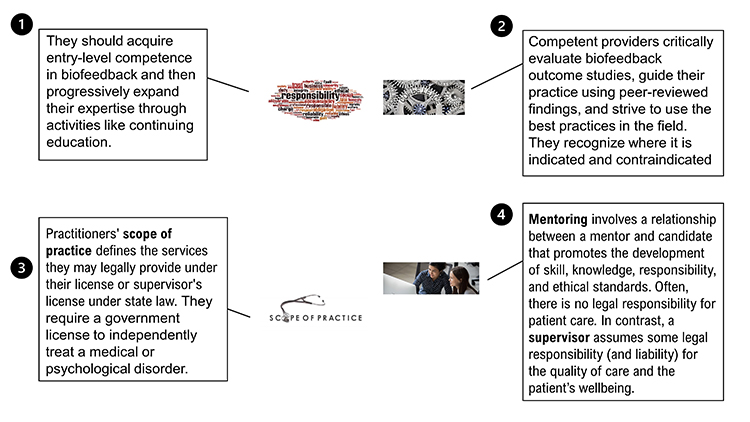
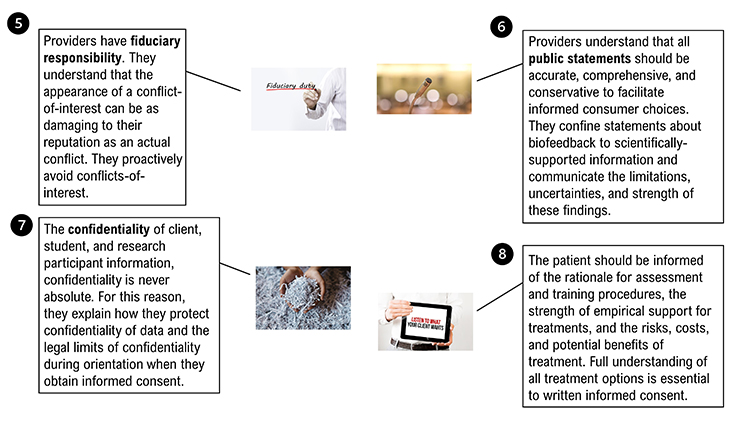
Glossary
anonymity: protection of a client's identity.
BCIA: the Biofeedback Certification International Alliance.
certificant: an individual who has been certified by BCIA.
certificate of completion: recognition by BCIA that an applicant has completed an approved didactic workshop based on BCIA's blueprint and passed an exam over its content.
certification: BCIA recognition that an applicant has met its requirements for entry-level competence in providing biofeedback services.
client: a recipient of biofeedback services.
common vehicle transmission: the transfer of infectious organisms by equipment, including cables and sensors
competence: level of proficiency.
confidentiality: a client's right to keep personal information private.
continuing education: organized learning experiences undertaken after a credential has been earned to ensure up-to-date knowledge.
dual relationship (also called multiple relationship): a situation where a healthcare provider and patient share multiple roles. For example, when a client is also an employee.
efficacy: effectiveness.
ethics: the branch of philosophy that deals with moral issues.
functional overdose: a drug overdose that can occur when biofeedback training reduces a patient's requirement for a drug. For example, biofeedback training may lower a patient's blood pressure to the extent that the prescribed dose may produce hypotension and fainting.
informed consent: a written and signed statement in which participants voluntarily confirm their willingness to participate in a research study following disclosure of all aspects of the study relevant to their decision to participate.
licensure: legal permission granted to a professional to practice a profession.
mentorship: a relationship between a mentor and candidate that promotes the development of skill, knowledge, responsibility, and ethical standards in the practice of biofeedback
provider: the professional who supervises biofeedback training.
supervision: the provision of guidance for clinical practice for qualified health professionals by a more experienced health professional who assumes legal responsibility and liability for the quality of the services provided.Test Yourself
Click on the ClassMarker logo to take 10-question tests over this unit without an exam password.
REVIEW FLASHCARDS ON QUIZLET
Click on the Quizlet logo to review our chapter flashcards.
Visit the BioSource Software Website
BCIA offers two HRV Biofeedback Certification paths: Biofeedback and Neurofeedback. For Biofeedback, BioSource Software offers Human Physiology to satisfy BCIA's Human Anatomy & Physiology requirement. For Neurofeedback, BioSource provides Physiological Psychology to satisfy BCIA's Physiological Psychology requirement.
BCIA has accredited each course, and they combine affordable pricing ($150) with industry-leading content.
Assignment
Based on your own clinical experience, what are the hardest ethical decisions you've made in biofeedback practice?
References
Association for Applied Psychophysiology and Biofeedback (1994). Clinical efficacy and cost effectiveness of biofeedback therapy: Guidelines for third party reimbursement (2nd ed.). Author.
Association for Applied Psychophysiology and Biofeedback (1995). Clinical applications of biofeedback and applied psychophysiology: A series of white papers prepared in the public interest by AAPB. Author.
Association for Applied Psychophysiology and Biofeedback (2003). Ethical principles of applied psychophysiology and biofeedback (4th revision). Author.
Biofeedback Certification International Alliance (2016). Professional standards and ethical principles (9th rev.).
Biofeedback Certification International Alliance (2011). What is certification?
Biofeedback Certification International Alliance (2015). Why choose BCIA biofeedback certification?
Crawford, J. (2013). What's new with BCIA? Biofeedback, 41(3), 85-87. https://doi.org/10.5298/1081-5937-41.3.07
Crawford, J., & Shaffer, F. (2014). What BCIA learned from Bob Dylan. Biofeedback, 42(1), 9-11. https://doi.org/10.5298/1081-5937-42.1.05
Hagedorn, D. (2014). Infection risk mitigation for biofeedback providers. Biofeedback, 42(3), 93-95. https://doi.org/10.5298/1081-5937-42.3.06
Hammond, D. C., Bodenhamer-Davis, G., Gluck, G., Stokes, D., Harper, S. H., Trudeau, D., MacDonald, M., Lunt, J., & Kirk, L. (2011). Standards of practice for neurofeedback and neurotherapy: A position paper of the International Society for Neurofeedback & Research. Journal of Neurotherapy, 15(1), 54-64. https://doi.org/10.1080/10874208.2010.545760
Hopkins, B. (2013). Legal aspects of counseling: What you don't know might hurt you. Workshop presented at the Biofeedback Society of Texas conference, Austin, Texas.
Humane care and use of animals (A 343401) (Federal Regulations).
Moss, D. (2013). Professional conduct in biofeedback and neurofeedback. Workshop presented at the International Society for Neurofeedback and Research conference, Dallas, Texas.
Moss, D. (2020). Professional conduct in biofeedback and neurofeedback. BCIA Webinar. presented to BCIA.
Moss, D., Hagedorn, D., Combatalade, D., & Neblett, R. (2019). “A guide to normal values for biofeedback.” In D. Moss & F. Shaffer (eds)., Physiological recording technology and applications in biofeedback and neurofeedback. Association for Applied Psychophysiology and Biofeedback.
Regulations for the protection of human research subjects (45 CFR46 and 56 FR 28003) (Federal Regulations).
Shaffer, F., Crawford, J., & Moss, D. (2012). What is BCIA really? Biofeedback, 40(4), 133-136.
Shaffer, F., & Schwartz, M. S. (2016). Entering the field and assuring competence. In M. S. Schwartz and F. Andrasik, Biofeedback: A practitioner's guide (4th ed.). The Guildford Press.
Striefel, S. (1999). Practice guidelines and standards in psychophysiological self-regulation. Wheat Ridge, Colorado: Association for Applied Psychophysiology and Biofeedback.
Striefel, S. (2003). Professional ethics and practice standards in mind-body medicine. In D. Moss, A. McGrady, T. Davies, and I. Wickramasekera (Eds.), Handbook of mind-body medicine for primary care. Sage Publications, Inc.
Striefel, S. (2004). Practice guidelines and standards for providers of biofeedback and applied psychophysiological services. Association for Applied Psychophysiology and Biofeedback.
Sullivan, L. R., & Altman, C. L. (2008). Infection control: 2008 review and update for electroneurodiagnostic technologists. American Journal of Electroneurodiagnostic Technology, 48, 140-165. PMID: 18998475





